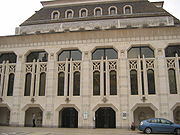
Guildhall Art Gallery
Encyclopedia

City of London
The City of London is a small area within Greater London, England. It is the historic core of London around which the modern conurbation grew and has held city status since time immemorial. The City’s boundaries have remained almost unchanged since the Middle Ages, and it is now only a tiny part of...
, England
England
England is a country that is part of the United Kingdom. It shares land borders with Scotland to the north and Wales to the west; the Irish Sea is to the north west, the Celtic Sea to the south west, with the North Sea to the east and the English Channel to the south separating it from continental...
. It occupies a building that was completed in 1999 to replace an earlier building destroyed in The Blitz
The Blitz
The Blitz was the sustained strategic bombing of Britain by Nazi Germany between 7 September 1940 and 10 May 1941, during the Second World War. The city of London was bombed by the Luftwaffe for 76 consecutive nights and many towns and cities across the country followed...
in 1941. It is a stone building in a semi-gothic style intended to be sympathetic to the historic Guildhall
Guildhall, London
The Guildhall is a building in the City of London, off Gresham and Basinghall streets, in the wards of Bassishaw and Cheap. It has been used as a town hall for several hundred years, and is still the ceremonial and administrative centre of the City of London and its Corporation...
, which is adjacent and to which it is connected internally.
The gallery was originally built in 1885 to house art collections from the City of London Corporation and the present collection consists of about 4,000 works, of which around 250 are on display at any one time. Many of the paintings are of London themes. There is also a significant collection of Victorian era
Victorian era
The Victorian era of British history was the period of Queen Victoria's reign from 20 June 1837 until her death on 22 January 1901. It was a long period of peace, prosperity, refined sensibilities and national self-confidence...
art, including Pre-Raphaelites, which features paintings by artists such as John Everett Millais
John Everett Millais
Sir John Everett Millais, 1st Baronet, PRA was an English painter and illustrator and one of the founders of the Pre-Raphaelite Brotherhood.-Early life:...
and Edwin Landseer, and a view of Salisbury Cathedral
Salisbury Cathedral
Salisbury Cathedral, formally known as the Cathedral Church of the Blessed Virgin Mary, is an Anglican cathedral in Salisbury, England, considered one of the leading examples of Early English architecture....
by John Constable
John Constable
John Constable was an English Romantic painter. Born in Suffolk, he is known principally for his landscape paintings of Dedham Vale, the area surrounding his home—now known as "Constable Country"—which he invested with an intensity of affection...
. The centrepiece of the largest gallery is John Singleton Copley
John Singleton Copley
John Singleton Copley was an American painter, born presumably in Boston, Massachusetts, and a son of Richard and Mary Singleton Copley, both Irish. He is famous for his portrait paintings of important figures in colonial New England, depicting in particular middle-class subjects...
's huge painting The Defeat of the Floating Batteries at Gibraltar
The Defeat of the Floating Batteries at Gibraltar, September 1782
The Defeat of the Floating Batteries at Gibraltar, September 1782 is the title of a 1783 oil-on-canvas painting by Boston-born American artist John Singleton Copley...
.
The Guildhall complex was built on the site of London's Roman amphitheatre
Amphitheatre
An amphitheatre is an open-air venue used for entertainment and performances.There are two similar, but distinct, types of structure for which the word "amphitheatre" is used: Ancient Roman amphitheatres were large central performance spaces surrounded by ascending seating, and were commonly used...
, and some of the remains of this are displayed in situ in a room in the basement of the art gallery. Discovered in 1998, the site is now a protected monument. It is under the Guildhall Art Gallery. London's first Roman amphitheatre
Roman amphitheatre
Roman amphitheatres are amphitheatres – large, circular or oval open-air venues with raised seating – built by the Ancient Romans. They were used for events such as gladiator combats, chariot races, venationes and executions. About 230 Roman amphitheatres have been found across the area of the...
was built in AD70 from wood but was renovated in the early 2nd century with tiled entrances and ragstone walls. The amphitheatre
Amphitheatre
An amphitheatre is an open-air venue used for entertainment and performances.There are two similar, but distinct, types of structure for which the word "amphitheatre" is used: Ancient Roman amphitheatres were large central performance spaces surrounded by ascending seating, and were commonly used...
was used for various public events such as gladiator
Gladiator
A gladiator was an armed combatant who entertained audiences in the Roman Republic and Roman Empire in violent confrontations with other gladiators, wild animals, and condemned criminals. Some gladiators were volunteers who risked their legal and social standing and their lives by appearing in the...
games, entertaining soldiers and the public with animal fighting and public execution of criminals, as well as religious activities. When the ancient Romans left in the 4th century the amphitheatre lay derelict for hundreds of years. In the 11th century the area was reoccupied and by the 12th century the first Guildhall was built next to it.
External links
- Guildhall Art Gallery New website

